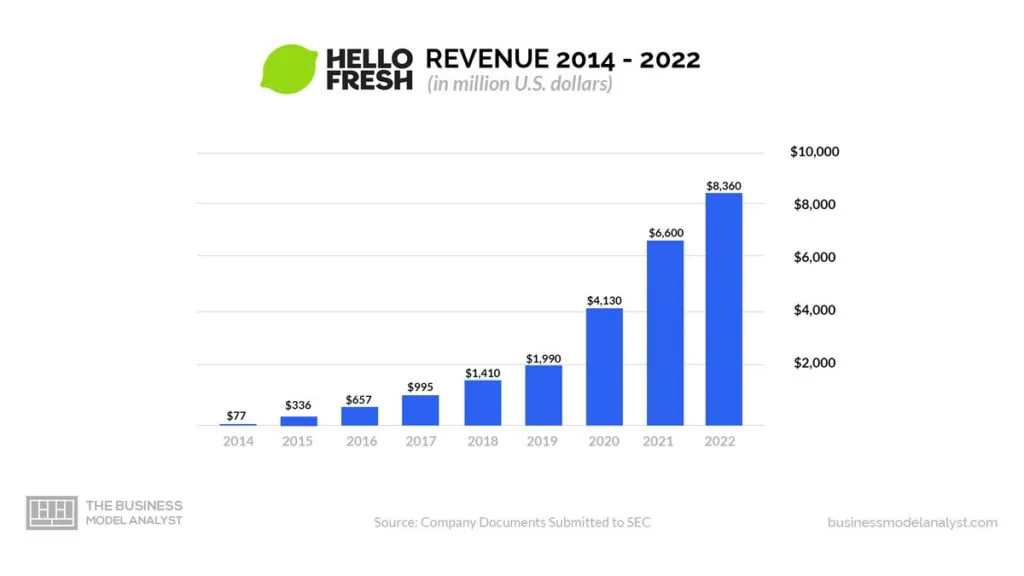Is HelloFresh profitable? Yes, the meal kit delivery company has seen significant growth over the last few years and has managed to maintain profitability. However, the brand has seen a recent slowdown in this solid upward trajectory in the last few years.
Let’s examine the factors contributing to the company’s success, how it maintains profitability, and what choices it may need to make to survive in an ever-changing business environment.
Contents
Timeline of HelloFresh’s Financial Growth and Funding
HelloFresh is a meal kit delivery company that has experienced significant financial growth since its inception. Here is a timeline of HelloFresh’s financial growth and funding:
- 2011: HelloFresh was founded in Berlin, Germany, by Dominik Richter, Thomas Griesel, and Jessica Nilsson. The company initially launched in Germany;
- 2012: HelloFresh expanded its operations to the Netherlands and the United Kingdom;
- 2013: The company expanded further into Austria, Belgium, Australia, and the United States;
- 2014: HelloFresh raised €50 million ($64 million) in a funding round led by Insight Venture Partners, Phenomen Ventures, and Vorwerk Ventures;
- 2015: HelloFresh raised an additional $85 million in a funding round led by Baillie Gifford, Insight Venture Partners, and Phenomen Ventures. The company also acquired its main competitor in the United States, Green Chef;
- 2017: HelloFresh went public on the Frankfurt Stock Exchange, raising €318 million ($369 million) in its initial public offering (IPO);
- 2018: The company raised €257 million ($300 million) in a capital increase. This funding round was led by Baillie Gifford, with participation from existing investors;
- 2019: HelloFresh reported revenue of €1.81 billion ($1.95 billion), representing a growth of 41.4% compared to the previous year;
- 2020: HelloFresh experienced significant growth due to the COVID-19 pandemic, as more people turned to meal kit delivery services. The company reported a revenue of €3.75 billion ($4.5 billion), representing a growth of 107.4% compared to the previous year;
- 2021: HelloFresh continued to benefit from the increased demand for meal kits, reporting revenue of €4.74 billion ($5.6 billion), representing a growth of 26.4% compared to the previous year;
- 2022: The company continued its strong growth and saw an uptick in its shares at the end of Q1. However, the year ended on a less positive note as the company had to lay off 600 employees, and the meal kit industry took a significant downturn;
- 2023: Company shares dropped by as much as 12.7% due to reduced demand for their services, as well as an expected drop in subscribers.
HelloFresh Financial Performance: Revenues, Expenses, and Profits.
HelloFresh Revenue

HelloFresh operates on a subscription-based revenue model that has proven to be highly successful in the meal kit delivery industry. With its innovative approach to home cooking, HelloFresh has transformed how people prepare meals by providing convenient and personalized solutions.
At the core of HelloFresh’s revenue model is its subscription service. Customers sign up for weekly or monthly subscriptions and select the number of meals they want to receive.
While the company has not yet released data concerning its revenue for the current year, HelloFresh reached an annual revenue of €7.6bn, indicating a 27% increase from the €6.0bn realized the previous fiscal year. This is a continuation of the strong growth trend the company has seen over the past few years.
- 2014: €70.2 million (approximately $77 million)
- 2015: €304.9 million (approximately $336 million)
- 2016: €597 million (approximately $657 million)
- 2017: €904.9 million (approximately $995 million)
- 2018: €1.28 billion (approximately $1.41 billion)
- 2019: €1.81 billion (approximately $1.99 billion)
- 2020: €3.75 billion (approximately $4.13 billion)
- 2021: €6.0 billion (approximately $6.6 billion)
- 2022: €7.6 billion (approximately $8.36 billion)
The company achieved a 25.5% contribution margin for the entire year of 2022 (as against 25.3% in 2021), despite record levels of inflation in ingredients and labor. The contribution margin is a financial metric that represents the percentage of revenue remaining after deducting variable costs directly associated with producing goods or services, and is an essential indicator of a company’s profitability and efficiency.
HelloFresh attained a total of €477.4 million in adjusted EBITDA, demonstrating a margin of 6.3%. This performance showcases the company’s ability to surpass global e-commerce competitors in terms of financial achievement. EBITDA is a metric used to assess a company’s operating performance by excluding certain non-operating expenses.
HelloFresh Expenses
As a meal kit delivery company, HelloFresh incurs various expenses in its operations. Some of the everyday expenses that HelloFresh is likely to have included:
- Cost of Goods Sold (COGS): This includes the expenses associated with procuring the ingredients and packaging materials for the meal kits. It encompasses the costs of purchasing food items, packaging materials, and any other direct costs related to producing the meal kits;
- Fulfillment and Distribution Costs: HelloFresh needs to handle delivering and distributing its meal kits to customers. This involves expenses such as warehouse operations, inventory management, packaging, shipping, and logistics. These costs cover the processes required to ensure that the meal kits are delivered accurately and in a timely manner;
- Marketing and Advertising Expenses: HelloFresh invests in marketing and advertising to promote its brand, attract new customers, and retain existing ones. This includes expenses related to digital and traditional advertising campaigns, social media marketing, influencer partnerships, and other promotional activities;
- Technology and Operations: HelloFresh relies on technology to manage its operations efficiently. This includes expenses associated with developing and maintaining its website, mobile applications, customer management systems, and other technological infrastructure. Additionally, costs related to customer support, quality control, and process improvement initiatives fall under this category;
- General and Administrative Expenses: HelloFresh incurs general administrative costs to support its overall operations. These expenses cover salaries and benefits for employees, rent for office spaces, utilities, legal and accounting fees, insurance, and other administrative overhead;
- Research and Development: HelloFresh invests in research and development to continuously improve its meal offerings, develop new recipes, and enhance the overall customer experience. These expenses cover activities such as recipe development, menu innovation, and product testing.
HelloFresh Profit
HelloFresh has seen a recent drop in its expected profits for the year, with analysts expecting a net financial gain of between €460 million and €540 million, below the expected €547 mark.
Potential for Profitability
Strategies to profitability
HelloFresh must explore various opportunities to ensure continued growth and profitability. Strategies to maintain and increase profitability include market expansion, product diversification, personalization, partnerships, sustainability, subscription model optimization, data analysis, operational efficiency, customer experience enhancement, and corporate partnerships.
Below, we can see several opportunities that HelloFresh can explore:
- Market expansion is crucial for HelloFresh’s growth. By entering new regions with a demand for convenient and healthy meal options, HelloFresh can broaden its customer base and benefit from economies of scale, solidifying its position as a global leader;
- Product diversification beyond meal kits to include snacks, desserts, or beverages aligns with HelloFresh’s mission and offers additional revenue streams. Leveraging its existing customer base, HelloFresh can introduce products that cater to evolving consumer preferences;
- Offering increased personalization and customization options enhances customer satisfaction and attracts a broader range of customers seeking tailored meal solutions;
- Partnerships and collaborations with food-related brands or influencers increase brand awareness, expand HelloFresh’s reach, and tap into partner brand customer bases;
- Emphasizing sustainability with eco-friendly packaging and practices attracts environmentally conscious customers and reduces costs;
- Optimizing subscription models encourages long-term subscriptions and customer loyalty through tiered benefits and loyalty programs;
- Leveraging customer data for data-driven decision-making in menu planning, inventory management, and targeted marketing strategies;
- Continual optimization of the supply chain and operational processes improves efficiency, reduces costs, and maintains quality and customer satisfaction;
- Investing in an enhanced customer experience with faster delivery, improved support, and user-friendly platforms fosters customer loyalty and positive referrals;
- Corporate partnerships, such as offering customized meal solutions for workplaces or universities, create new revenue streams and expand the customer base.
By strategically looking into these opportunities, HelloFresh can thrive in the meal kit industry, considering market conditions, customer preferences, and business goals to ensure sustained growth and profitability.
Challenges that HelloFresh Faces as a Business
HelloFresh faces challenges related to competition, operational complexity, customer retention, sustainability, and supply chain disruptions. Successfully addressing these challenges requires continuous innovation, operational efficiency, customer-centric strategies, sustainability initiatives, and effective risk management.
One significant challenge for HelloFresh is the increasing competition in the meal kit industry. As the market grows, more players enter, including both established companies and new startups. This intensifies competition for market share and customer acquisition, requiring HelloFresh to continuously innovate and differentiate its offerings to stay ahead.
Managing operational complexity is another challenge. HelloFresh operates a complex supply chain involving sourcing, packaging, and delivery logistics. Ensuring timely delivery of fresh ingredients and coordinating with multiple suppliers and delivery partners can be demanding. Maintaining efficiency and quality control throughout the process while scaling operations is crucial to meet customer expectations.
Customer retention is essential for HelloFresh’s long-term success. While acquiring new customers is important, retaining existing ones is equally vital. HelloFresh must consistently deliver high-quality meals, excellent customer service, and convenient experiences to retain its customer base amidst growing options and changing preferences.
Addressing sustainability concerns is becoming increasingly crucial for HelloFresh. Customers are increasingly conscious of environmental impact and expect sustainable practices from companies. HelloFresh must actively work towards reducing packaging waste, sourcing ingredients responsibly, and adopting eco-friendly practices to meet these expectations.
Supply chain disruptions pose challenges for HelloFresh. Disruptions in ingredient availability, transportation delays, or unforeseen events can impact operations and lead to customer dissatisfaction. HelloFresh needs to proactively manage its supply chain, build resilient relationships with suppliers, and have contingency plans in place to mitigate such disruptions.
By navigating these challenges effectively, HelloFresh can maintain its position as a leader in the meal kit industry and ensure long-term success.
Conclusion
HelloFresh has demonstrated profitability over the years, with significant revenue growth and impressive financial performance. However, the company faces challenges in maintaining its upward trajectory, such as increased competition, operational complexity, customer retention, sustainability concerns, and supply chain disruptions.
To sustain profitability, HelloFresh must employ strategies such as market expansion, product diversification, personalization, partnerships, sustainability initiatives, subscription model optimization, data analysis, operational efficiency, enhanced customer experience, and corporate collaborations.
By addressing these challenges and capitalizing on opportunities, HelloFresh can continue to thrive in the meal kit industry and ensure long-term profitability.


